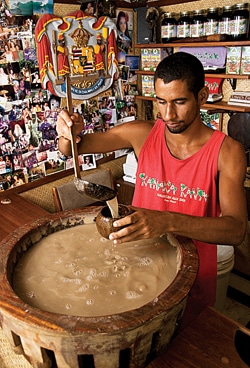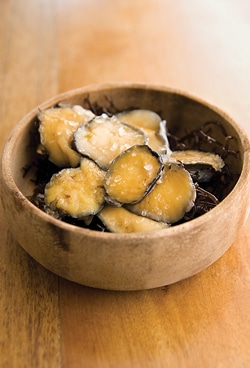Taste: Raw And Real In Hawaii
"They're kind of disgusting ... but really good," says the young man behind the counter at the kava bar. That's not exactly the reaction I was expecting when I asked about the opihi on the menu. Here on the Big Island of Hawaii I'm eager to try authentic flavors that I've never had before, but now I'm worried. While I waffle, the man, sporting nothing but shorts, sandals and a chestful of blue-black tattoos, hands me a coconut shell filled with kava. I find out his name is Sage. "You can see opihi at the beach," he says. "They're those little black shells that cling to the rocks." He's trying to make the case for me to order them, but he's effectively doing the opposite.
"So what do they taste like?" I ask. Sage concentrates for a moment, as if looking for the right wording. Finally, he says, "They taste like the ocean."
That's what I'm looking for. With the same sense of adventure some tourists reserve for exploring coral reefs or lava fields, I've spent a week on the Big Island stalking typical Hawaiian dishes. I've gone from Kailua Kona in the west to Hilo in the east, hitting diners and platelunch joints. And I've found some pretty exotic specimens – the results of centuries of Asian, Polynesian, European and American culinary influences. I plowed through servings of loco moco (hamburger patties with a fried egg, rice and gravy) and chicken katsu (fried Japanese style), all accompanied by big scoops of macaroni salad. I slurped through a deep bowl of saimin noodles, and of course I had Spam musubi, slices of grilled Spam on blocks of sushi rice. But after a week of carb loading, I want a taste of Hawaii itself. A taste that's raw.
That's how I ended up here at a pocket-sized joint called Kanaka Kava tucked into a shopping center in Kailua Kona, on the west coast of the Big Island. I discovered the place while on an aimless evening stroll down Ali'i Drive, Kailua Kona's main oceanfront street. One look at the crowd, and I knew I had stumbled onto a local secret. At long community tables surrounding the restaurant's outdoor serving counter, surfer girls with wind-tousled hair and old beachcombers in threadbare aloha shirts commune over kava, a bitter drink famed for its purported antidepressant and relaxing properties.
I order a bowl of opihi. Sage wrangles one of the bar's owners, Johanna Gibson, to answer the questions he can't. Opihi, she says, are commonly called limpets, and they've long been a staple of the traditional Hawaiian diet. In the past few years, opihi have become scarce in Hawaii; conservationists believe they've been overpicked and advocate stricter laws regarding their harvest. "Most people who like opihi have their own favorite spots and pick for themselves," Johanna tells me. "But picking can be dangerous. Opihi like to grow on the rocks where the surf is the roughest. I'm sure you've heard the song 'Opihi Man' by the Ka'au Crater Boys?"
I had not. Turns out, it's a celebration of the opihi picker's dangerous life: Like the crab on the rock, you gotta run real fast. / Keep your eye on the wave, don't ever turn your back. / Opihi man in the sun, opihi man, grab your bag and run. / Opihi man, another swell is coming your way ... .
I realize that I had seen these creatures just the day before near 'Ahalanui Pond on the Big Island's eastern tip. The surf that afternoon was powerful; fast, frothy waves pounded the stony shoreline. Clinging to the rocks through wave after wave were small black shells, an inch or two in diameter , shaped like shallow, wide cones – tiny oceanic versions of Hawaii's famous volcanoes. I assumed they were a kind of barnacle, but now I know: These are opihi, relatives of snails. When Sage brings me my opihi, I'm famished, probably as hungry as the Hawaiian who first thought these rock-dwelling creatures looked appetizing.

In my bowl are about a dozen black-and-gray, glistening oval shells, each with a putty-colored "foot" the size of a quarter. The shell's snail-like inhabitants have been removed, and they are patently unattractive. They're usually eaten raw. The only garnish here is a sprinkling of Hawaiian salt.
I pop one in my mouth. At first, the flavor is aggressively marine, like getting a deep breath of wild sea spray. They look a little like oysters, but they're much tougher to bite through – a testament to a life spent clutching a wave-battered rock for survival. As I chew the clamlike belly, I evaluate it like a fine wine. Is that a seaweed brine with a sun-baked-sand overtone and a hint of flint?
No, this isn't the island's greatest dish. But the opihi does take me deeper into Hawaii. This tells a tale of an island born at the bottom of the sea and its rise to the surface – a primordial story not of people, but of earth and water. As I eat my way through the bowl, I look around at my fellow diners and kava drinkers, native Hawaiians and tourists alike.
In the distance, we hear the rumble of the deep, dark ocean that surrounds us, forever crashing on the shore. All of us are clinging like little snails to the same black rock.
By the time I eat my last opihi, I'm not even thinking in terms of flavor. This bracing bite is elemental and pure. Finally, I have found Hawaii.
